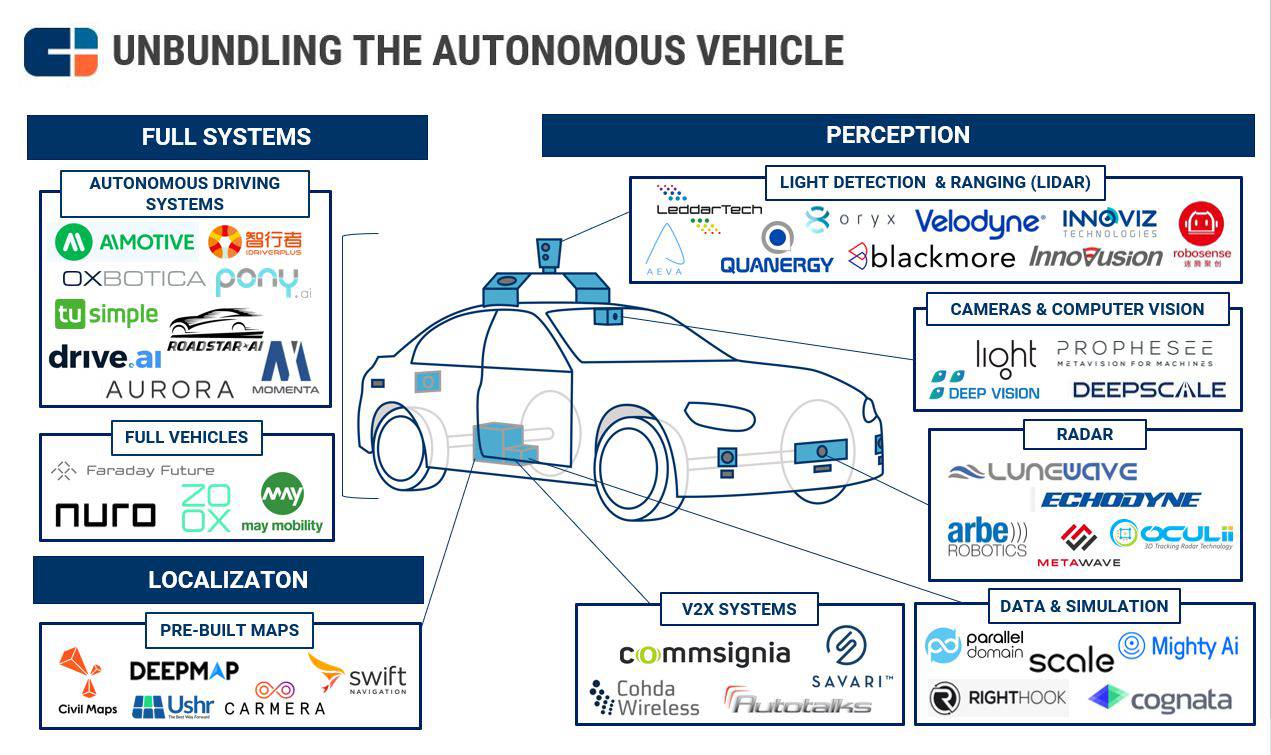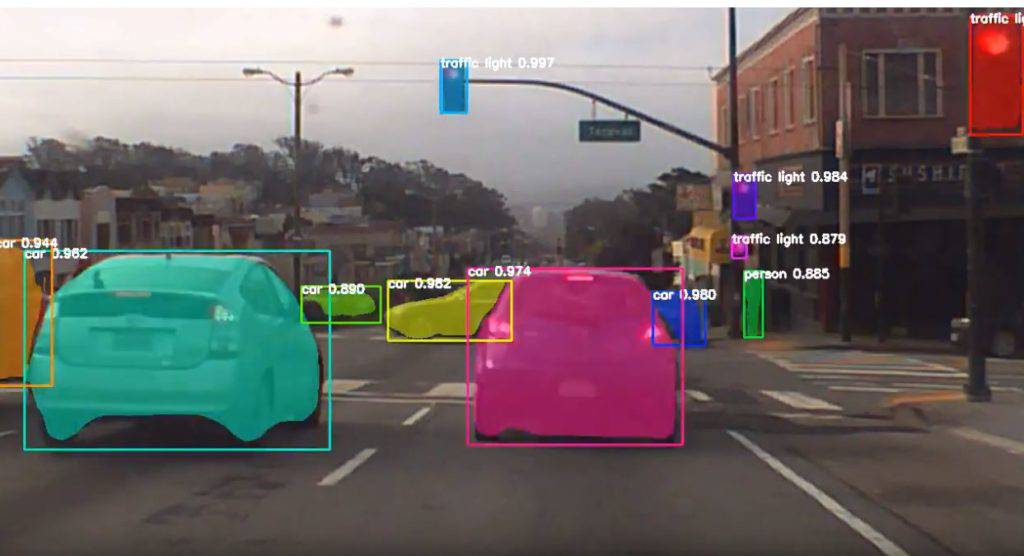Unbundling The Autonomous Vehicle Who's Who, What's What Inwards The Underlying Technology
From CB Insights, Oct 31:
Autonomous vehicles rely on several advanced technologies to self-navigate. We unbundle the AV to come across how these technologies operate together and which companies are driving them forward.


Autonomous vehicles rely on several advanced technologies to self-navigate. We unbundle the AV to come across how these technologies operate together and which companies are driving them forward.
Autonomous vehicles rely on a prepare of complementary technologies to sympathise too response to their surroundings.
Some AV companies are focusing on these specific components too partnering amongst automakers too Tier-1 suppliers to help convey their products to scale spell others, such every bit Zoox too Nuro, are designing their vehicles from the solid soil up.
We accept a closer await at the many technologies that brand autonomous driving possible and map out the startups looking to brand AVs to a greater extent than advanced, less costly, and easier to scale.
This marketplace map consists of private, active companies exclusively too is non meant to last exhaustive of the space. Categories are non mutually exclusive, too companies are mapped according to primary purpose case.

Please click to enlarge.
Perception
Autonomous vehicles own got to last able to recognize traffic signals too signs every bit good as other cars, bicycles, too pedestrians. They also own got to feel an oncoming object’s distance too speed too thence that they know how to react.

AVs typically rely on cameras too other sensors such every bit radar too lite detection too ranging (lidar), each of which offers its ain prepare of advantages too limitations.
The information collected past times these sensors is blended together through a engineering called “sensor fusion” to create the virtually accurate representation of the car’s surround every bit possible.
Cameras & figurer vision
Cameras are universally used in autonomous vehicles and vehicles equipped amongst advanced driver assistance systems (ADAS). Unlike radar too lidar, cameras tin position colors too fonts, which assist let on route signs, traffic lights, too street markings.
However, cameras pale inwards comparing to lidar when it comes to detecting depth too distance.
Influenza A virus subtype H5N1 set out of startups are looking to create cameras for the automotive infinite that extract the virtually brilliant images possible.
Light, which raised $121M inwards Series D inwards July, has developed a photographic idiot box camera designed to compete amongst lidar’s accuracy. The photographic idiot box camera tin integrate images across all of its sixteen lenses to extract a highly-accurate 3D image.
To procedure the information pulled inwards from the cameras, AV systems use computer vision software that’s trained to let on objects too signals. The software should last able to position specific details of lane boundaries (e.g. draw color too pattern) too assess the appropriate traffic rules.
Influenza A virus subtype H5N1 set out of startups are looking to develop to a greater extent than sophisticated too to a greater extent than efficient figurer vision technology.
Companies like DeepScale are deploying deep neural networks to enhance recognition capabilities too hold an improving mistake charge per unit of measurement over time.
Paris-based Prophesee has developed event-based machine vision that facilitates object recognition and minimizes data overload. The company’s deep learning engineering mimics how the human encephalon processes images from the retina.
Frame-based sensors inwards a criterion photographic idiot box camera rely on pixels that capture an ikon all at the same fourth dimension too procedure images frame-by-frame; event-based sensors rely on pixels working independently from each other, allowing them to capture displace every bit a continuous current of information.
This engineering reduces the information charge that traditional cameras experience when processing an ikon from a serial of frames.
Prophesee is looking to deploy its machine vision capabilities across several industries, from autonomous vehicles to industrial automation to healthcare. In February, the startup raised $19M inwards a Series B follow-on round.
Radar, LiDAR, & V2X
AV developers are incorporating radar too lidar sensors to heighten the camera’s visual capabilities.
AVs use sensor fusion — software that integrates the information from all sensors to create i coherent persuasion of the car’s surround — to procedure the information coming from the multitude of sensors.
Beyond line-of-sight sensors, a set out of startups too auto incumbents are working on vehicle-to-everything (V2X) technology, which allows vehicles to wirelessly communicate amongst other connected devices.
The engineering is nonetheless inwards its early on days, but it has the potential to provide vehicles amongst a alive feed of nearby vehicles, bicycles, too pedestrians — fifty-fifty when they’re exterior the vehicle’s draw of sight.
Radar
Cars purpose radar to let on an oncoming object’s distance, range, too velocity past times sending out radio waves.
Radar engineering is viewed every bit to a greater extent than reliable than lidar because it has a longer detection arrive at too doesn’t rely on spinning parts, which are to a greater extent than prone to error. It’s too substantially less costly. As a result, radar is widely used for autonomous vehicles too ADAS.
Lunewave, which raised $5M inwards seed funding from BMW too Baidu inwards September, is using 3D printing to create to a greater extent than powerful antennas amongst greater arrive at too accuracy. The company’s engineering is based on the Luneburg antenna, which was developed inwards the 1940s.
Metawave is too working to heighten radar’s capabilities. The fellowship has developed an analog antenna that uses metamaterials for faster speeds too longer detection ranges.
Metawave’s $10M follow-on seed circular inwards May included investments from large auto names such every bit DENSO, Hyundai, too Toyota, every bit good every bit smart coin VC Khosla Ventures. The trouble solid announced Tier-1 supplier Infineon’s contribution to a follow-on circular inwards August.
Light detection too ranging (lidar)
Lidar is viewed every bit the virtually advanced sensor. Its high accuracy is capable of creating a 3D rendering of the vehicle’s surroundings, facilitating object detection.
Lidar engineering uses infrared sensors to create upward one's heed an object’s distance. The sensors mail out pulses of Light Amplification by Stimulated Emission of Radiation lite at a rapid charge per unit of measurement too stair out the fourth dimension it takes for the beam to homecoming to its surface.
Traditional lidar units contain a set out of spinning parts that capture a 360° persuasion of the car’s surroundings. These parts are to a greater extent than expensive to develop, too tend to last less reliable than stationary parts. Startups are working to trim back the toll of lidar sensors spell maintaining high accuracy.
One solution is solid-state lidar units, which own got no moving pieces too are less costly to implement.
Israeli startup Innoviz has developed solid-state lidar engineering that volition toll “in the hundreds of dollars,” a fraction of the toll of Velodyne’s $75,000 lidar unit, which contains 128 lasers.....MUCH MORE
In April, Innoviz announced a partnership amongst automaker BMW too Tier-1 supplier Magna to deploy its lidar Light Amplification by Stimulated Emission of Radiation scanners inwards BMW’s autonomous vehicles.
Aeva is too developing solid-state lidar. It raised $45M inwards Series Influenza A virus subtype H5N1 funding inwards October. The company claims that its engineering has a arrive at of 200 meters and costs only a few hundred dollars. Unlike traditional lidar, Aeva’s engineering shoots out a continuous moving ridge of lite instead of private pulses.
China-based Robosense is developing solid-state lidar. It raised $43.3M inwards Series C funding inwards October, the largest unmarried circular of financing for a lidar fellowship inwards China. Investors inwards the circular included Alibaba’s logistics arm Cainiao Smart Logistics Network too automakers SAIC too BAIC....
No comments